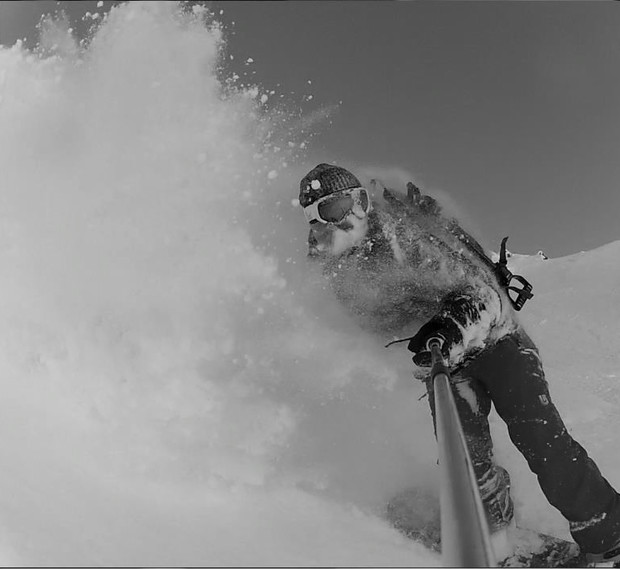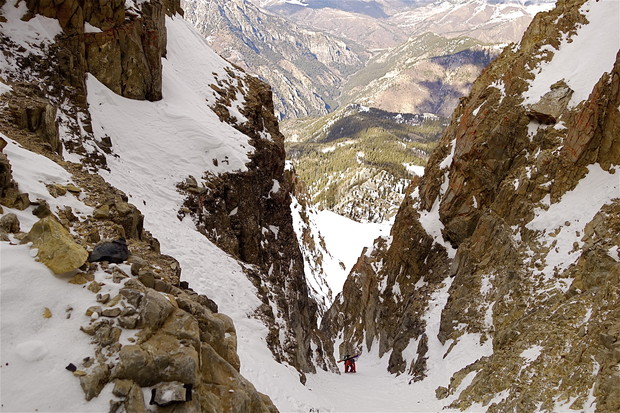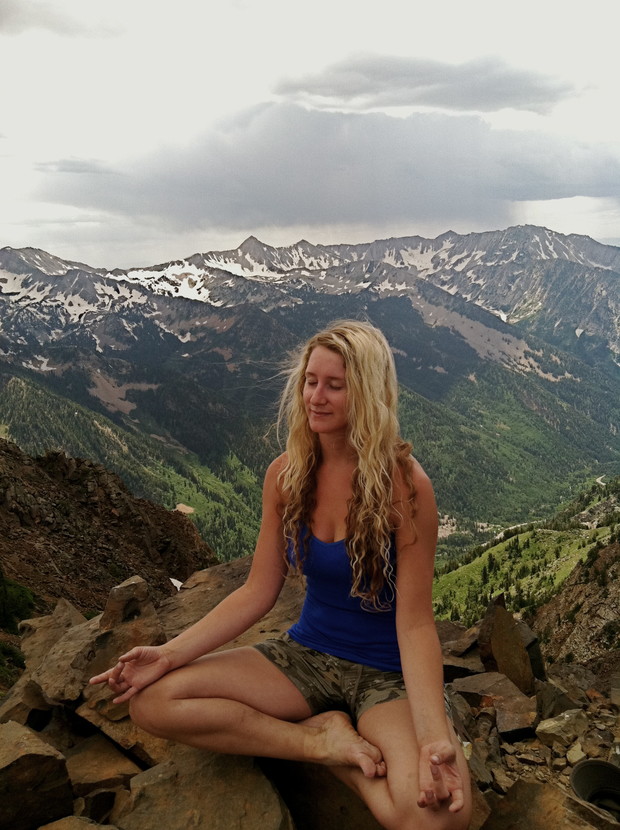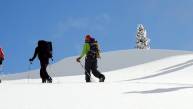tags:
Cindi Lou Grant |
tgr news |stress relief |stress |splitboard |split personality |mind |mental health |meditation |dopamine |backcountry

When I am climbing mountains on my splitboard, I understand that my thoughts and attitude effect how far and how fast I can go. I also notice how much better I feel after taking the time to meditate before and/or after a day of peak bagging. I’ve been fascinated by exploring the validity of positive visualization meditation, how it affects successfully climbing mountains, the influence it has on recovery, and if it can determine how much endurance I have. As a yoga teacher, professional snow slasher, and an ever aspiring mountaineer, I’m excited to share this fascination with you.
Meditation was intended as a spiritual practice for monks and nuns as a way to gain a deeper understanding of the human mind. We learn to momentarily detach from the environment so that new perspectives of it can arise. Eventually it eases the suffering caused by our attachment to the superficial things in life. Splitboarding is also known to sever this attachment because it requires us to be in-tune and focused. Commonalities between meditation and splitboard mountaineering align in the subtleties.
Basic meditation is simply learning to observe our thoughts and become aware. By learning to observe rather than react, we are enabled to choose which thoughts we want to react to and which ones to let go. We can then make informed decisions about our environment and monitor our emotional attachments. You can achieve this by simply sitting with yourself and learning your own thought pathways.
 Not every day is an easy, fun day on the mountain; sometimes you have to consciously choose your morale for the sake of yourself or the group. Cindi Lou Grant photo.
Not every day is an easy, fun day on the mountain; sometimes you have to consciously choose your morale for the sake of yourself or the group. Cindi Lou Grant photo.
Many have experienced this behind the scenes. Professional skier & worldwide mountaineer Andrew McLean said, “ I do firmly believe in positive mental imagery - you have to see yourself succeeding.” From the book, "Mountaineering: The Freedom of the Hills", the author offers us this truth. “Morale is intangible, but it makes a party stronger. Morale is often the deciding factor in party’s success, and it is always the deciding factor in making the climb enjoyable. Morale is everybody’s job.”
We ultimately have complete control of morale and it contributes to the group dynamic immensely. I have found mantras (a statement repeated frequently) boost my moral and positive mental imagery. If we choose thoughts like, “this hurts”, “I’m beat”, “I can’t go on”. Then this is the reality we’ve created from limiting thoughts. On the other hand, “This is making me stronger”, “I’m so thankful I have opportunity to do this”, “I will get there.” Then that is the reality we choose and the overall vibe contribution is a positive one. Meditation is training our minds to monitor and realize these pathways.
Life is suffering- one of Buddhism’s four noble truths. More applicably, splitboarding up a huge mountain with intent to ride it doesn’t happen without a fair amount of suffering. Some expeditions can even be referred to as a “suffer-fest” and we put ourselves through grueling long hours to achieve the summit we’ve deemed as a worthy accomplishment. It is intense and even painful at times, yet we push on. When we exercise at this level our bodies make all kinds of chemicals. It is in this chemical response that we can scientifically prove the benefits meditation can offer a splitboarder.

While climbing we use up oxygen faster, we produce more oxidative stress with the chemical cortisol and our ph becomes more acidic, according to a study out of Washington University. Pain and suffering can occupy your mind, and if you let it become your belief you probably won’t continue. Obviously this is not the only, or successful, way of experiencing it. There is enjoyment that comes from the “suffer-fest”; some sort of strange pleasure. One aspect of this pleasure comes from a chemical called dopamine that our bodies make as we exercise and it affects our bodies and our attitudes. It is this pleasure that makes us crave more, this pleasure can even become addictive. The dopamine is like a drug and some people build up a craving for it while others could take it or leave it.
After a long day on the mountain our bodies also make another chemical called melatonin. According to a study conducted by the Department of Experimental Medicine and Public Health at the University of Camerino; you can help increase your gusto in the hills with meditation because it creates more of the chemical melatonin.
In the study, 16 athletes where put into two groups. Both groups went through an intense 8 hour mountain bike ride. After the ride, tests were taken to record everyone’s exercise- induced oxidative stress levels. Oxidative stress is a condition where there is an increase of oxidation in cells, along with the production of the chemical cortisol, they cause free radicals that degenerate the cells. Afterwards, one group did a deep diaphramic breathing meditation and the others just simply relaxed; both in similar rooms. After an hour they were tested again. Here are their findings:

The melatonin that we make is a hormone produced in order to relax and it is also an antioxidant that counteracts oxidative stress. By decreasing cortisol levels and increasing melatonin, the meditative breathing prevents oxidative damage from happening. With your body more able to process the stress, you are able to go further. Meditation also increased the oxygen intake in their blood streams. This occurs because of the deep breathing practiced in all meditation modalities. More oxygen in the blood stream makes for more readily available energy supplies.
Therefore, I encourage using meditation as a tool in order to increase our suffering thresholds. Meditation can range from simple, just sitting and focusing on breathing everyday or even every week, to visualization, to yoga, and even simple encouraging mantras. Any type can help to combat all the stress we put ourselves through by pushing our physical limits to achieve our lofty goals. This beautiful practice can make us healthier, more focused, and we may even learn more about ourselves as a result of it.
12 STEPS TO HELP FACILITATE MEDITATION

#1) Set aside a special place away from everyone, or with everyone, depending on your group dynamic. How you set up this space will help with concentration. This place will eventually develop an aura of its own that helps facilitate meditation. I like to find flat rocks, take my closed cell pad to a place with a view, or just sit in my tent if I’m not at home.
#2) Pick a time when your mind can be free. (Dawn or dusk is best because of the calm energy level.) Using the same time and place each day helps the mind to calm more quickly. I prefer dusk because it won’t interfere with dawn patrol missions.
#3) Sit with your back straight in line with your neck and head. Proper alignment will help you stay focused and eventually help your general posture.
#4) Pick a direction. (north & east are the positive poles of the earth, and so they may be good choices.)
#5) Suggest to the mind that, it is time to slow down and rest the soul.
#6) Slow and deepen the breath
#7) Now let it go and let the body find a natural rhythm.
#8) Let the mind wander at first to clear out the thoughts. You can step back and observe almost like your thoughts are just sweeping by on their own or like birds flying past in the sky.
#9) Eventually bring the mind on to a focal point like breath or candle gazing works well. If the mind wanders from your focus don't be forceful, bring it back gently.
#10) Meditation is a process not a destination. It occurs when you reach a state of full awareness and your sensitivity enhances.
#11) Eventually duality disappears and samati which means unity of the mind, body and soul, comes to be.
#12) Don’t aspire to or try to force anything particular to happen, just let it run the course on its own. The more you do it the smoother your mind becomes.
15-MINUTE MEDITATIONS
So-Hum: Start seated in a comfortable position. “Perfect pose” has a nice feel to it. You sit “Indian style” and then bring your bottom leg so it touches your other thigh and bring the top of you foot into the crease in your bent leg. Bring your attention to the breath and just simply notice it. Start to inhale So and exhale Hum. SoHum means “I am that” connect with yourself without any thoughts or preconceptions of who you are. Just be.
Four-Part Breathing: Start sitting comfortably. Any way that feels good in fine. Even lying down in savasana is very beneficial. When we lay with our backs flat it gives the vertebrae in our spines a chance to reabsorb the water the gets lost throughout the day. Bring your awareness to your breath. Start to breathe in for 10 seconds; hold in for 5; out for 10; hold out for 5. Continue to flow with this breath. If you get distracted by a thought or an impulse, acknowledge it without judgment and come back to your breath.
Slow Hands: Sit comfortably and shake out your hands. Bring your hands to your thighs and notice the sensation of your pulse in your fingers. Breathing all the while. Start to breathe into your belly filling it up. As you are inhaling, imagine a bright light emanating from you core or power chakra. As you exhale the light gets dimmer and brighter on the inhale pulsing with breath. Very slowly, start to bring your palms to face each other. Notice any sensation of the movement. See the light that was in you core, as a ball in between your hands. Pulse your hands slowly and feel the sensation of the light. Now imagine the ball is the earth and the light from your breath is healing energy. Heal the world as you hold this light around it.
Air: Stand in tadasana, mountain pose, with your eyes closed. Breath in as if your whole core, chest, and shoulders are an empty vase. Filling it up from the bottom up. As you are breathing imagine you are at the bottom of the ocean standing in tadasana and breathing freely. Feel your arms- is there an undulation as the tide comes in and goes out? This ocean you are imagining is the same ocean of air that we live in everyday. It sustains us and gives us life.









__video_thumb.jpg)



__video_thumb.jpg)